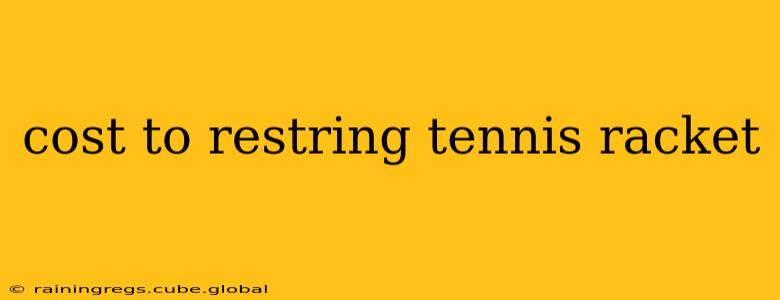Restringing your tennis racket is crucial for maintaining optimal performance and preventing injuries. However, the cost can vary significantly depending on several factors. This comprehensive guide will break down the price, influencing factors, and help you make informed decisions about your racket's maintenance.
What Factors Influence the Cost to Restring a Tennis Racket?
Several factors contribute to the overall cost of restringing your tennis racket. Understanding these will help you budget accordingly and choose the best option for your needs.
1. Type of String:
This is arguably the biggest cost driver. Strings range from budget-friendly synthetics to high-performance natural gut.
- Synthetic Gut: The most affordable option, offering a good balance of durability and playability. Expect to pay less for these strings.
- Natural Gut: Considered the premium choice, offering exceptional feel, power, and comfort. However, this comes at a higher price point and requires more frequent restringing.
- Hybrid Strings: Combining synthetic and natural gut strings (often natural gut in the mains and synthetic in the crosses) provides a balance of performance and cost-effectiveness.
2. String Tension:
Higher string tension generally leads to a firmer feel and more control but can increase the risk of racket breakage and string snapping. Lower tension provides more power and comfort but may sacrifice some control. The tension you choose doesn't directly impact the labor cost but may influence the string cost if you need more durable strings for higher tension.
3. Racket Type:
The complexity of your racket's frame can influence restringing time and thus cost. Some rackets have more intricate designs that require more time and skill to restring correctly.
4. Location:
The cost of restringing can vary widely depending on your location. Larger cities and areas with a higher concentration of tennis players tend to have higher prices. Smaller towns or local shops might offer more affordable rates.
5. Service Provider:
Prices will vary between different restringers, from local shops to pro shops at tennis clubs to independent stringers. Pro shops often charge a premium for their expertise and convenience.
How Much Does it Typically Cost to Restring a Tennis Racket?
The total cost usually falls within a range, but expect to pay anywhere from $20 to $70 or even more. The lower end typically involves budget-friendly synthetic strings and a simpler racket. The higher end encompasses premium natural gut strings, high-tension requirements, and expert restringing services.
How Often Should I Restring My Tennis Racket?
The frequency of restringing depends on several factors, including your playing level, string type, and string tension. Generally, it’s recommended to restring your racket every 6-8 weeks of regular play. If you play very frequently or aggressively, more frequent restringing might be necessary. Signs your racquet needs restringing include noticeably less power or a dead feel to the ball.
Can I Restring My Tennis Racket Myself?
While it is possible to restring your own racket, it requires specialized tools and a considerable amount of skill and practice. Mistakes can easily damage your racket or lead to an improperly strung racket, impacting your performance and potentially causing injuries. It's generally recommended to have your racket professionally restringed unless you have significant experience in this area.
Where Can I Find Affordable Restringing Services?
Searching online for "tennis racket restringing near me" is a good starting point. You can also check with local tennis clubs or sporting goods stores. Comparing prices from multiple providers before committing will ensure you get the best value for your money.
By understanding these factors and considering your playing style and budget, you can make an informed decision about restringing your tennis racket and keep it in top playing condition. Remember, regular restringing is an investment in your game and injury prevention.
